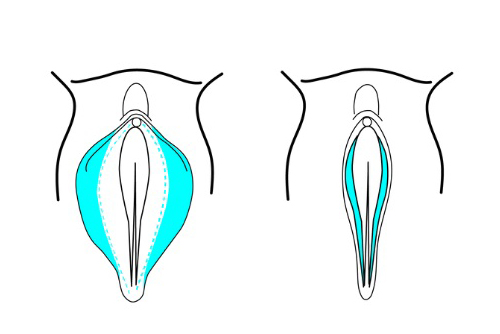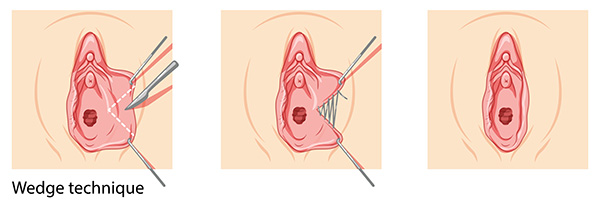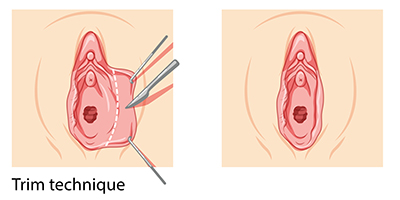Labia Correction Labiaplasty Methods, Aftercare and Price in Turkey

- Pain and Physical Problems Caused by Enlarged Labia
- Labia Reduction Labiaplasty Methods
- Labia Reduction Labiaplasty Prices
- Labiaplasty Care After The Operation
- Risks of Labiaplasty
Every woman who is thinking about having her labia reduced should know that the shape of the labia comes from genetics. So it is completely normal if the vaginal area does not correspond to the supposed ideal of youthfully firm outer labia that cover the inner labia. Larger or longer labia are not a medical reason for a labiaplasty (or labia correction).
Hormonal changes, pregnancy and the natural aging process can also change the shape of the labia. So far, there are no extensive studies on the length and size of the external female genitalia.
Pain and Physical Problems Caused by Enlarged Labia
Some women can suffer because their labia are too large or too long (hypertrophy of the labia). For example, because they have pain during sex or during sports (e.g. cycling or horseback riding) or because they get sore easily when they wear tight clothing. The level of suffering can be correspondingly high.In addition, it is not uncommon to limit sexual life. This is where vaginal labia correction labiaplasty can help: During this labia correction, a specialist in plastic and aesthetic surgery reduces the inner and/or outer labia in an operation.
Labia Reduction Labiaplasty Methods

Before the labia reduction, there is a detailed consultation and a thorough physical examination of the woman. The specialist explains to the patient about possible methods of labiaplasty, the course of the operation and the possible risks. Dr who is going to perform the surgery must also know in advance whether allergies, medication or previous illnesses are present and what kind of result the patient wants.

Labia correction is usually performed on an outpatient basis under general or local anesthesia. Which method the specialist uses varies from person to person. There are different incisions that he adapts to the respective findings. The procedure usually takes 60 to 90 minutes.
Surgical reduction of the inner labia
The goal is to harmoniously align the inner labia and make everything look natural.The surgeon shortens the protruding skin and fat tissue during labia reduction using:
- laser
- scalpel
- high frequency radio waves
Surgical reduction of the outer labia
If the outer labia of patient is too big or too long, a labiaplasty is an option. The specialist sucks off excess fatty tissue and/or surgically removes the remaining tissue.Surgeon then sews up the incisions with self-dissolving threads. This has the advantage that they do not have to be removed, which can be painful in the sensitive vaginal area.
Labia reduction without surgery
A non-surgical labia reduction is not an option for the inner labia. For mild problems with the outer labia, treatment with radio frequency energy is possible. Those interested in these treatment should seek detailed advice from an experienced specialist.It is not possible to shrink the labia by yourself with home remedies. A labia correction labiaplaty must be performed by a specialist.

Labia Reduction Labiaplasty Prices
The costs for the labia reduction depend on the findings and the surgical technique. In Europe Labiaplasty prices are between 2,200 and 3,000 euros.Health insurance usually does not cover the costs of a labiaplasty. But: If there is a medical indication (e.g. pain and severe mental stress), patient may be able to reimburse part of the costs for labiaplasty surgery upon application.
Labia reduction is usually carried out in a clinic or specialist practice, which the patient can leave after a short recovery phase. Genital corrections generally belong in the hands of experienced specialists in plastic and aesthetic surgery (or specialists in plastic surgery).
Labiaplasty Care After The Operation
The healing period after surgery varies from person to person. It depends on the type of surgery, the skill of the surgeon and the behavior of the operated patient after the procedure. The patient remains in the clinic or practice for one to two hours for labia correction aftercare. During this time she recovers from the procedure and the surgically corrected genital area is cooled with compresses. Anyone who smokes should refrain from doing so before and after the operation. Nicotine reduces the oxygen supply and makes wound healing more difficult.Immediately after labiaplasty, labia reduction or labia correction, swelling, bruising and pain which the specialist treats with painkillers can occur. Bleeding is very rare after a labiaplasty, but it is a reason to contact your doctor immediately.
It is important to rest after the operation, to walk as little as possible at first and not to go back to work immediately.
For the first six weeks after labiaplasty surgery you should avoid the following:
- sports, such as horseback riding or cycling
- sex
- physical activities
You can take a shower the day after the operation - preferably with clear water or a very mild soap. Chamomile rinses, ointments that promote wound healing and careful scar care can also be useful.
The healing period varies from person to person. Since the area is well supplied with blood, the wound usually heals quickly and the scar is hardly visible after the labia reduction.

Control Visit After Labiaplasty
The first follow-up takes place often a week after the labiaplasty procedure. The final result can be seen after three weeks to three months.
Risks of Labiaplasty
Labiaplasty is considered relatively safe. However, as with any other surgery, there are some risks. The main possible complications are:
- problems with wound healing
- infections
- bleeding
- thrombosis
If a corrective operation is necessary, this is also associated with additional costs.
There are no comments yet. Would you like to add a comment?
In accordance with Article 10 of the Personal Data Protection Law (PDPL,KVKK) titled Data Controller's Obligation to Disclose, we use cookies in accordance with the legislation, limited to the purposes specified in the privacy policy.

